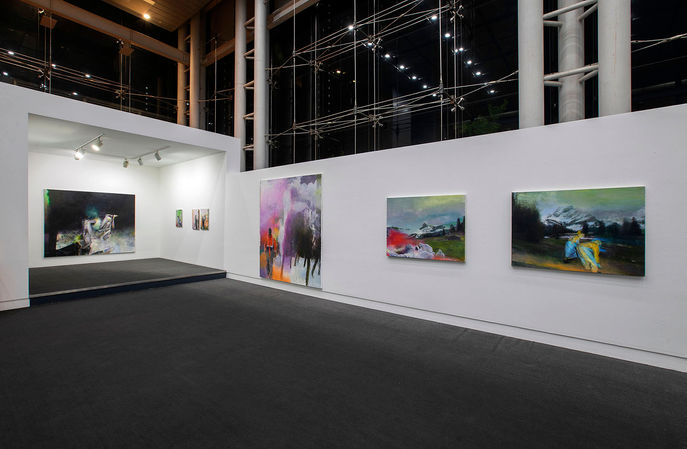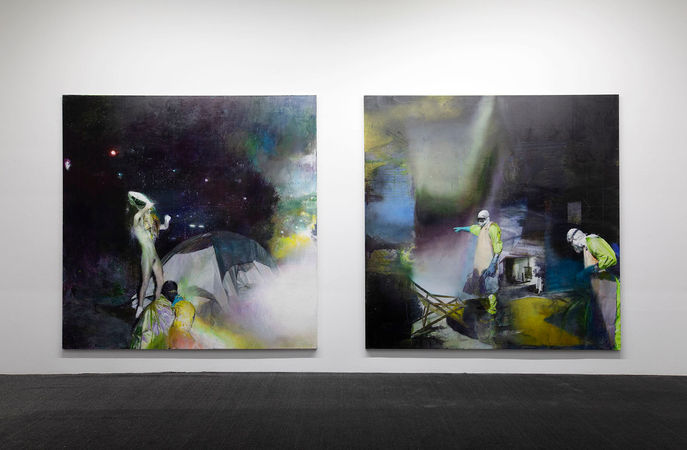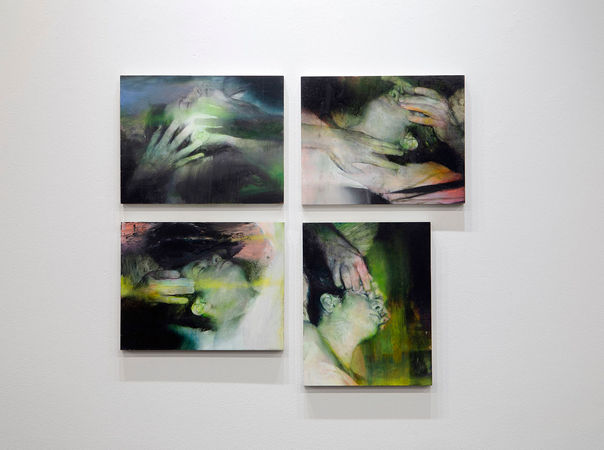For my further artistic practice I would like research the accelerating effect the implementation of digital technology and algorithms has on an individual.
For my further artistic practice I would like research the accelerating effect the implementation of digital technology and algorithms has on an individual.
Artworks and Processes
Artworks and Processes
Artworks and Processes
Artworks and Processes
Here is a heading
Ich bin ein Textabschnit. Klicke hier, um deinen eigenen Text hinzuzufügen und mich zu bearbeiten. Ich bin ein Textabschnitt. Klicke hier, um deinen eigenen Text hinzuzufügen und mich zu bearbeiten.Ich bin ein Textabschnitt. Klicke hier, um deinen eigenen Text hinzuzufügen und mich zu bearbeiten.Ich bin ein Textabschnitt. Ich bin ein Textabschnitt. Klicke hier, um deinen eigenen Text hinzuzufügen und mich zu bearbeiten. Ich bin ein Textabschnitt. Klicke hier, um deinen eigenen Text hinzuzufügen und mich zu bearbeiten.Ich bin ein Textabschnitt. Klicke hier, um deinen eigenen Text hinzuzufügen und mich zu bearbeiten.Ich bin ein Textabschnitt.
Here is a heading
Ich bin ein Textabschnit. Klicke hier, um deinen eigenen Text hinzuzufügen und mich zu bearbeiten. Ich bin ein Textabschnitt. Klicke hier, um deinen eigenen Text hinzuzufügen und mich zu bearbeiten.Ich bin ein Textabschnitt. Klicke hier, um deinen eigenen Text hinzuzufügen und mich zu bearbeiten.Ich bin ein Textabschnitt. Ich bin ein Textabschnitt. Klicke hier, um deinen eigenen Text hinzuzufügen und mich zu bearbeiten. Ich bin ein Textabschnitt. Klicke hier, um deinen eigenen Text hinzuzufügen und mich zu bearbeiten.Ich bin ein Textabschnitt. Klicke hier, um deinen eigenen Text hinzuzufügen und mich zu bearbeiten.Ich bin ein Textabschnitt.
Justin Mortimer

© Justin Mortimer, Ikidusama Study, 2020
Oil on canvas, 70 x 45 cm.
“There is something about the tension between reality and abstraction and to the point where it almost falls apart. The illusion starts to fragment and the paintings are like two brush strokes away from collapse and I really really like that.”
– Justin Mortimer
disorder of modern society
tension between reality and abstraction
hidden, the clouding, the mystery
pictural space starts to collapse
image maps
figures as ciphers
The artist´s website → http://justinmortimer.co.uk/
Justin Mortimer was born in Cosford, UK in 1970 and lives and works in London, UK. He combines realistic techniques with strong abstract expressions of figure painting. His work captures the disorder of modern society while at the same time the paradoxical beauty in the landscape of oppression and violence around the world shines through. (Space K, 2020) “These paintings are loaded with ambiguities surrounding their cause and context and consistently invite us to question the relationship between subject matter and content” (Sotheby´s, 2014).
© Justin Mortimer, Ikidusama Study, 2020
He works with collaging and applies several layers of collages on top of each other when he is painting. He lets his paintings “grow”. The grid is his scaling up tool and it is always there because every day he tends to re-grid, to add in the next layer.
(Beware the Artist Episode 013, 2021)
Transcribed passages
© Beware the Artist Episode 013 Justin Mortimer (28:36)
(5:16 – 5:41)
“The tension with the abstract kind of allowed me to relax as a painter. I could enjoy colour again. I could enjoy marks. Not having to be restricted by a certain reality - I´d allow myself certain realities like say for example the way light describes an arm and I would enjoy that and if I wanted to put it against a big yellow colour field - why not?”
(6:15 – 7:44)
“There is something about the tension between reality and abstraction and to the point where it almost falls apart. The illusion starts to fragment and the paintings are like two brush strokes away from collapse and I really really like that. (...) People were annoyed and asked why do I never completely reveal everything to viewer - and I like that. I like the hidden, the clouding, the mystery. (...) I have always rejected spoon feeding the viewer (...) I am interested in the mystery and the viewer has to work a little bit harder and I think that gives longevity to an image.”
(8:13 – 8:26)
“When the floor disappears when pictural space starts to collapse you have to wonder what is actually happening in this painting and then I maybe have to go in deeper. (...) I think my most successful paintings are that which are a bit more difficult and more awkward to read.”
(26:09 - 26:30)
“Do what you are good at and you will enjoy it. Because often, when you are good at something, it will come easily. If it comes easily people tend to mistrust that. If it comes easily thats not a bad thing - you are allowed to enjoy that. So yeah play out your strength.”
The Artist as a Junkie
by Justin Mortimer and Julien Delagrange




About the key principles behind his work
“I don’t spend much time thinking about the themes, they emerge intuitively. (…) What is undeniably changing is my approach to the painting itself. In some series I am allowing the abstract to come to the fore, and maybe a little bit more freedom in the painterly attack. I’m also interested in introducing new techniques, whether it be different oil mediums or spray painting. It’s been important to bring back the playful elements, the sheer enjoyment of smearing colour around. Sometimes we need to remind ourselves why we became painters in the first place.”
About his creative process
“I use an old version of photoshop to build digital collages as ideas for my paintings. I mainly use the cut and paste functions and tend to ignore all the rest as they are superfluous, and all the interesting stuff happens later with the actual painting. Before I had a computer, I made real paper collages from sources as varied as shopping catalogues, recipe books and my own photographs. Now I mine the internet and my own archive – I have shelves in my studio with old books from charity shops, second hand coffee table books with subjects as diverse as table decoration, home interiors, Swiss chalets, mountain tourist brochures and orthopedic surgery.
I scan in a page or two, slice them up digitally and manipulate these elements until I hit upon an idea I can work with. I like to keep this stage quite free and spontaneous. It’s part image choreography and part 2D model building.
I’ll generally spend a day roughing out these ideas on the computer and then make a few prints of them. These are my references, my image maps. I pin them next to my canvas and use them as if painting from observation. As the canvas develops and my ideas evolve, I make and print out more collages.
At a later stage I might photograph the painting and feed this back into the collage. When new images are painted onto the canvas, previous elements are often adjusted, covered over, scuffed up, defaced or renewed. The result usually means that there’s a fair bit of archaeology in there and sometimes, if I end up rejecting the painting, it serves as the initial layer for a new work.”
About the use of new technologies
“It all comes down to the talent of the artist if any work is lucky enough to become interesting. But I do worry that the tech is just so incredibly beguiling. It is so bloody easy to build an image now. You could spend a lifetime staring at the screen and never make another painting. Why bother? I have found myself making digital collages that are thrilling and very seductive – which I’d love to paint, but I know that the paint will not behave like the pixels. For a painting to succeed, it must exist separately from that digital catalyst, to exist in its own discreet world.”
About his urge of not depicting faces
“I have made many small paintings with faces. When it comes to my large pictures, I do feel a great urge to hide the face, to anonymize. I have often wondered why I do this. I think this is to do with the huge distraction a portrait creates – a massive interruption to the larger idea in the picture. Put in a face and the viewer’s gaze jumps straight to it, to the detriment of everything else. I think that my figures are ciphers, they are inhabitants of a world larger than their own particular story. I think they are representatives or surrogates for the theme rather than being the theme themselves. And the unspecified figure allows the viewer to occupy the painting either as protagonist or prey.”
About why he became a painter
“I love the way a painting is incontrovertibly connected to the character and physicality of the painter. I love the way a painting holds every mark made, the record of its making, the journey. It is a record of the artists presence. It exists outside the artists intentions.”
Key Takeaways
His work and his artistic process are very relevant to me because he plays with different realities on the canvas and uses an advanced collaging process to build them intuitively.
I am fascinated by how he varies between reality and abstraction, between details and coloured shapes. I think it is an interesting thought that he refuses to reveal everything to viewer and keeps the mystery as a part of his painting that give it more longevity.
I am also interested in his position towards the digital as a medium of image creation.
The way he anonymises the figure in his painting also speaks to me as I am opting for the same method in my recent work.
References
Delagrange, J (2021) The Artist as a Junkie. Available at: https://www.contemporaryartissue.com/an-interview-with-justin-mortimer-the-artist-as-a-junkie/ (Accessed: 03.04.22)
Sothebys (no date) This Side of Paradise / Lot 18. Available at: https://www.sothebys.com/en/auctions/ecatalogue/2014/this-side-paradise-curated-jane-neal-ls1402/lot.18.html (Accessed: 03.04.22)


